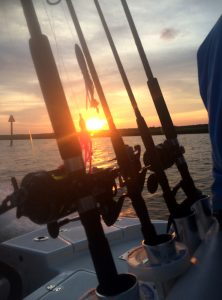Daniel Vance and I met Bo Hutchison Saturday morning to continue our search for the tarpon in McClellanville, a place we had never fished before.

We launched the boat at Buck Hall Plantation where we would be camping for the weekend. Buck Hall Plantation is a clean campground for RVs and tents overlooking the waterway. Oak and palmetto trees were scattered around and the grounds were well maintained. Each campsite had water, access to a restroom, and we had a dock for the boat which was a great upgrade from our last overnight tarpon trip.
We started off searching for bait which can be frustrating because the bait has to be caught, and there is no way to come prepared. Luckily, we were starting at dead low tide (which means mullet cannot hide in the grass) and were quickly able to stack up on large 8+ inch mullet. You can spend all day searching for bait but at some point, you have to get the hooks in the water. We started fishing at the mouth of Five Fathom Creek, where the shrimp boats pass to access the ocean, and the sharks quickly robbed all of our live bait. I could see the fin approaching the bait and would jerk the rod to dodge the shark, but sharks usually get what they want. We moved on and found pelicans diving on menhaden and were able to catch a few menhaden for bait.
We moved from one place to another all morning and never had much confidence in our spot until later in the afternoon, where we found two large sandbars causing a bottleneck in the water.
One of my friends had caught his first tarpon in McClellanville a few weeks earlier and did not give an exact location, but we assumed that this was his spot, based on the background in the picture.
The tide was rushing out from all the creeks and the baitfish were being funneled from between the two sandbars. We set anchor, dropped our bait in the water, and started chumming. If a tarpon was in the area, then we were going to make sure that it smelled us.
Pelicans dove around us and we were catching menhaden in the net as well as whiting and croaker on bottom rigs. Whiting and croaker make excellent tarpon bait and we use them on the surface or the bottom.
It was getting late and most other boats had left, but we waited until 7:30 before accepting defeat. We drove to McClellanville and docked the boat to eat at a seafood restaurant for supper. There was no better way to end the day.
Back at the campsite, Daniel and I slept in my tent and Bo slept in a hammock. We were uncomfortably hot as we went to sleep but were so tired that falling asleep was no trouble.
Before I knew it, my alarm clock sounded at 5:45, and we loaded the boat for round two.
I used a bait pen to keep our whiting, croaker, and mullet alive overnight so we wouldn’t spend too much time collecting bait.
We drove along the banks and could see plenty of mullet and red fish swimming together. We managed to catch some red fish while collecting bait and then went North to fish near the Cape Romain lighthouse.
Bo scooped some water in a 5 gallon bucket to wash of the deck and accidentally caught a jellyfish with long tentacles sprawled all over the side of the bucket. How he didn’t get stung was a miracle and he carefully dumped the jellyfish back into the inlet.
We sat anchored there for the entire incoming tide on a rip where two currents meet in the water and cause a line of bubbles and foam. The rip is always a good place to be and we were confident about our position. We saw two tarpon roll 200 yards behind us and I was hoping that they would catch our scent but the tarpon eluded us again.


